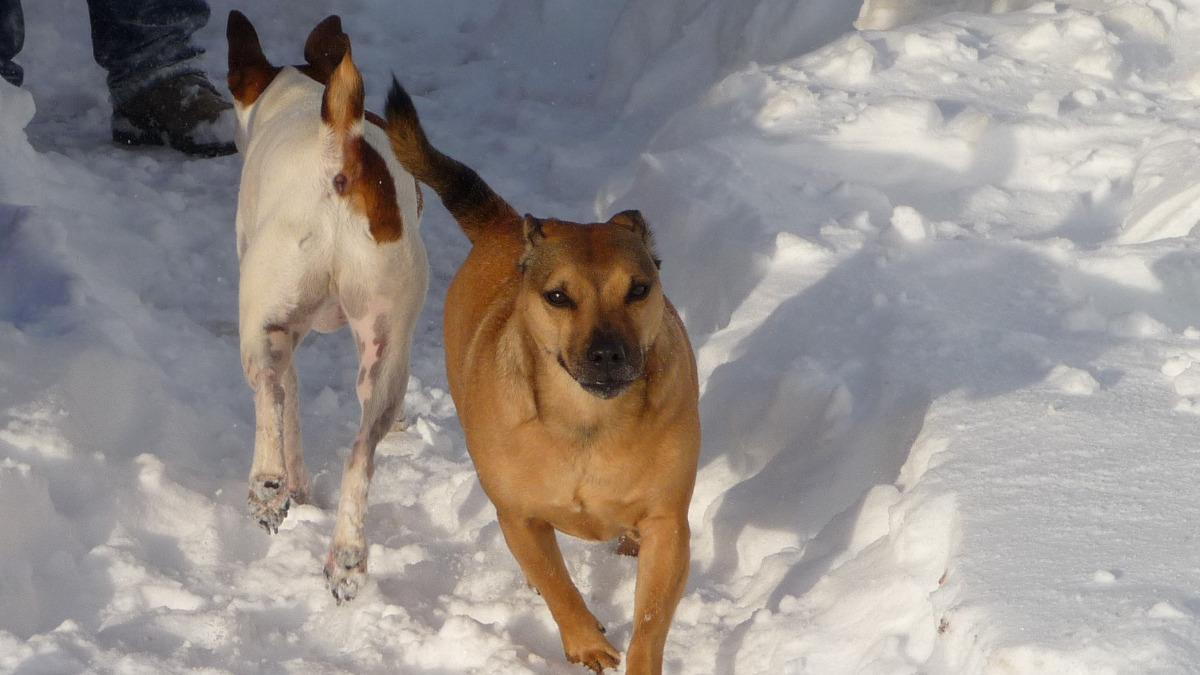Keeping Pets Safe in Cold Temperatures

- posted: Dec. 20, 2020
Keeping Pets Safe in Cold Temperatures
With our recent snowstorm, many dogs (and possibly a few cats!) enjoyed romping in the white stuff. But why do dogs and other animals like playing in the snow? And how long should pets be out in cold weather? Do they need coats or boots? Let’s learn how to keep pets safe in snowy weather.
Animals, especially dogs, have minds similar to those of toddlers. They enjoy new, novel experiences and seem to have a sense of wonder much like many humans do during the first snowfall of the year. Dogs like the sensory input and often roll around and stick their noses in the snow. Cats often like seeing the first flakes fall but often seem less enthused with heavier snowfall. Some dogs enjoy the snow more than others—short coated breeds such as greyhounds and smaller dogs like chihuahuas may get cold more easily than dogs with heavy coats built for snow like huskies and Bernese Mountain dogs.
How long should pets be allowed to play in the snow? Well, it depends on a lot of factors—your pet’s age, coat, breed, medical conditions. A young healthy dog or cat can probably stay outside for about thirty minutes if the weather is around or above freezing. The colder it is, the less time they should spend outside. That being said, if you are out with your dog for a walk or play session in the yard, and the dog seems comfortable and you’re not cold, play away! If your dog is shivering, stops playing or seems uncomfortable, go indoors. You should also limit time outside if your dog has a thin coat, is elderly, or has a medical condition.
Of course, you can put a coat on your pet to help keep him or her warm in cold or wet weather. Boots may be more challenging and are probably not necessary, but may be worth considering if your pup has to walk on roads or pavement in the winter. If it’s too cold for you to be out for more than a few minutes, it’s too cold for your pet. If you have cats or dogs who live solely outside, make sure they have adequate shelter with a heater or insulating substrate like straw. Bring them indoors in subzero temperatures if possible.
Dogs and cats can develop hypothermia and frostbite. With hypothermia, watch for shivering, pale gums, stumbling, lethargy or collapse. Bring pets indoors and gradually warm your pet with blankets and warm water bottles. Don’t use heating pads as pets could suffer burns or overheat. Frostbite can occur on areas like the tail, ears and toes with prolonged exposure to extreme cold. Affected skin may look bluish grey or pale, feels cold to the touch and may be painful. The skin becomes red, swollen and may peel and become more painful as it warms. If you think your pet has frostbite, apply a warm towel or tepid water to the area but don’t rub or use hot water as this can cause more damage. If the skin starts to look dark or black or feels hard, your pet needs immediate veterinary attention.
Check pets’ paws—ice can stick to fur between toes and cause discomfort. Pads can be cut by ice or irritated by ice melt and road salt. Wipe paws after your pet has been out for a walk, or consider those boots or a paw protecting wax or salve such as those used on sled dogs. Consider using pet safe versions of anti-freeze, window deicers and ice melt products.
While it’s fun to play with our pets in the snow, and many dogs and cats enjoy the white stuff, remember to limit time outside in extreme temperatures and enjoy the winter weather safely!
This blog brought to you by the Patton Veterinary Hospital serving Red Lion, York and the surrounding communities.
https://www.avma.org/resources-tools/pet-owners/petcare/cold-weather-animal-safety
https://www.southernliving.com/culture/pets/why-do-dogs-love-snow
https://www.petmd.com/dog/emergency/common-emergencies/e_dg_frostbite
Location
Patton Veterinary Hospital
425 E Broadway
Red Lion, PA 17356
